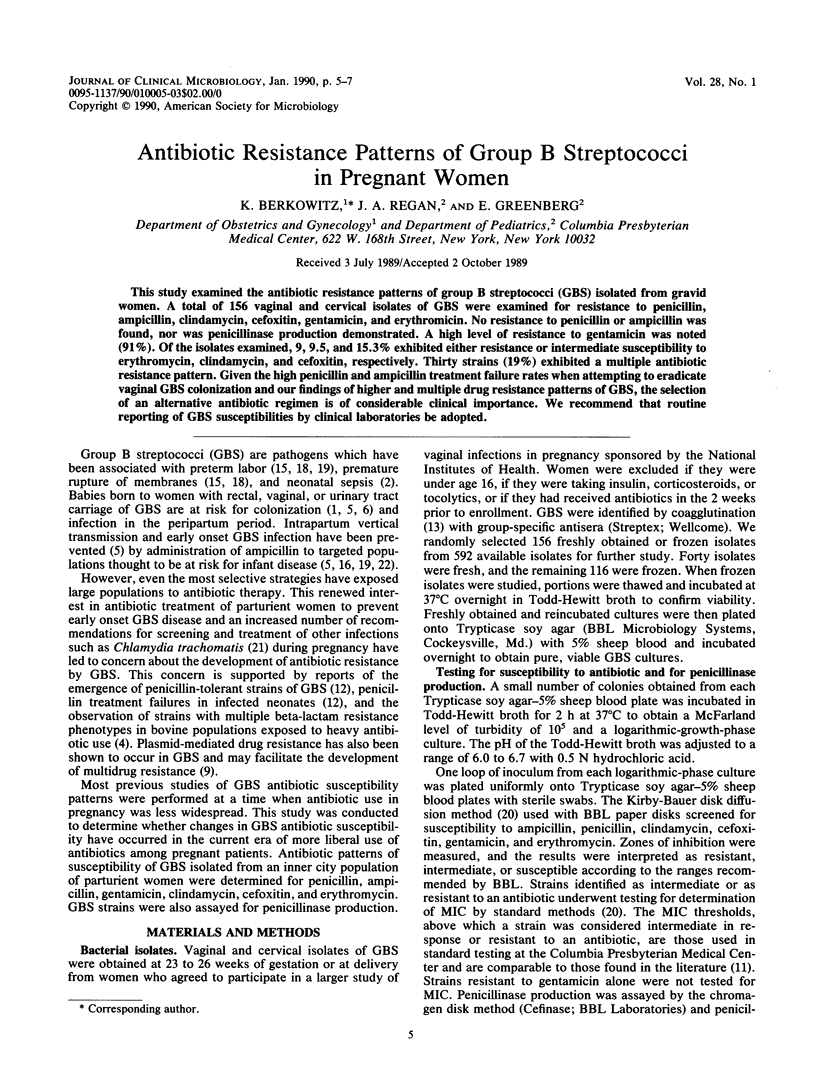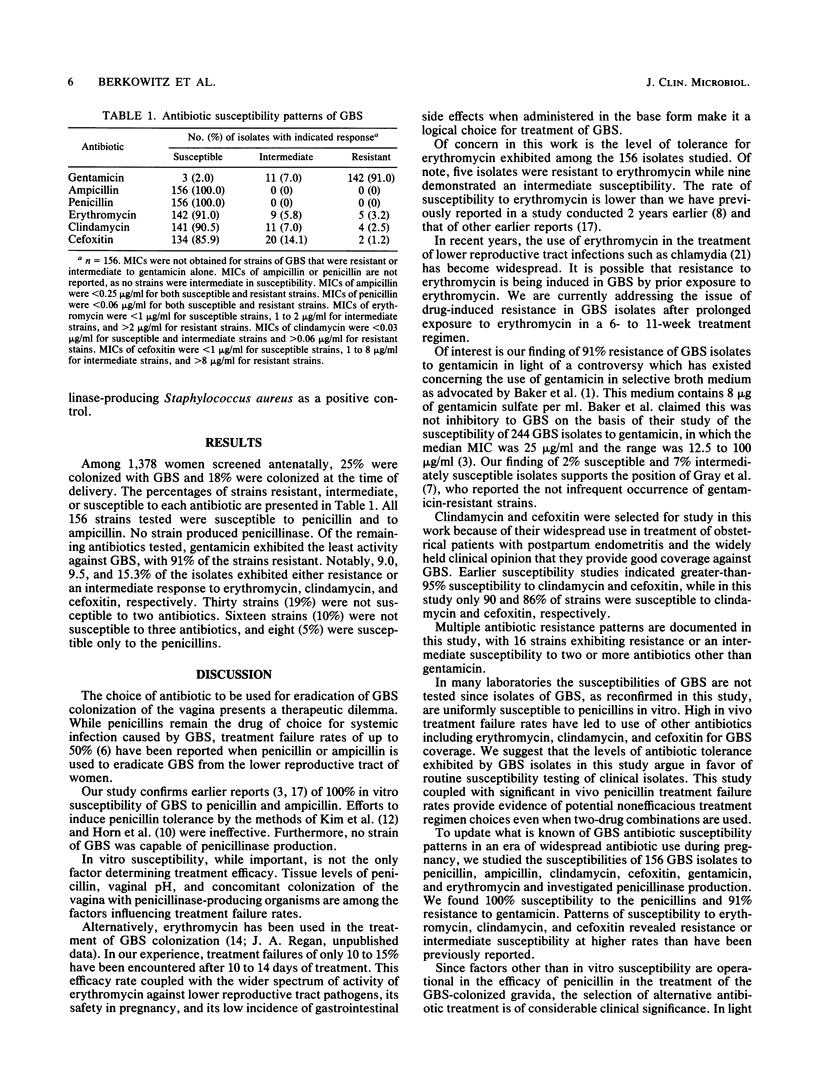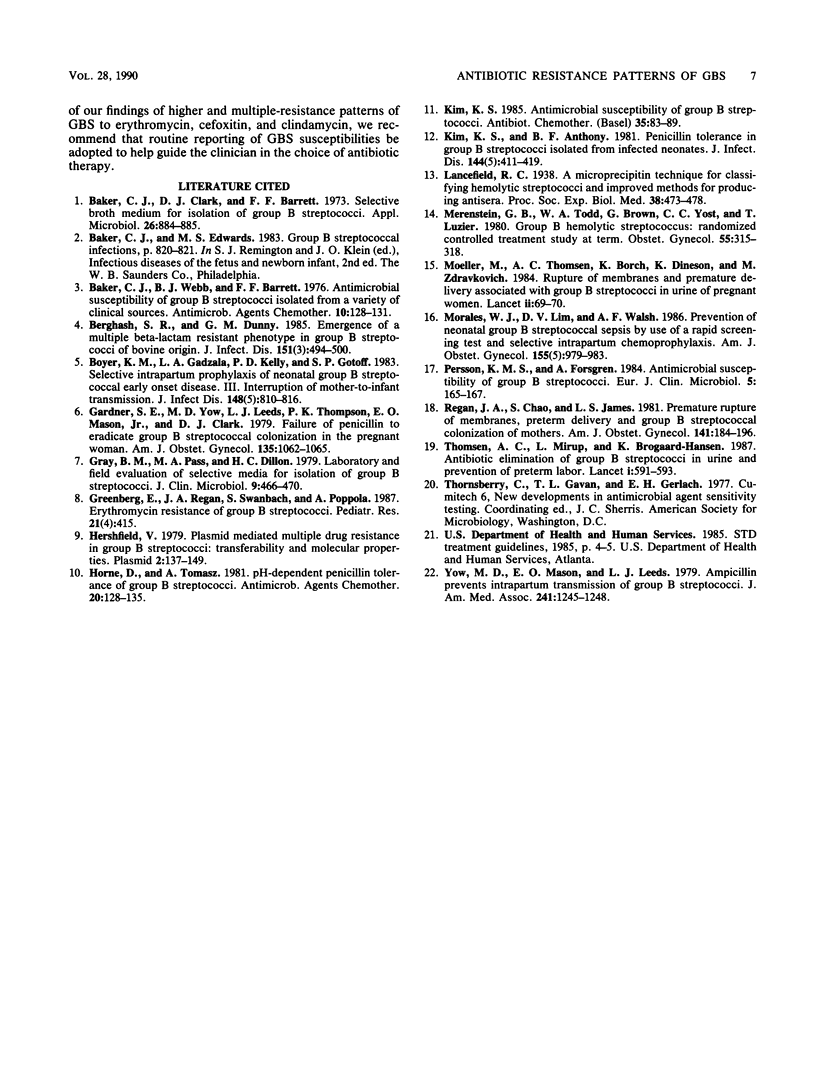Abstract
This study examined the antibiotic resistance patterns of group B streptococci (GBS) isolated from gravid women. A total of 156 vaginal and cervical isolates of GBS were examined for resistance to penicillin, ampicillin, clindamycin, cefoxitin, gentamicin, and erythromicin. No resistance to penicillin or ampicillin was found, nor was penicillinase production demonstrated. A high level of resistance to gentamicin was noted (91%). Of the isolates examined, 9, 9.5, and 15.3% exhibited either resistance or intermediate susceptibility to erythromycin, clindamycin, and cefoxitin, respectively. Thirty strains (19%) exhibited a multiple antibiotic resistance pattern. Given the high penicillin and ampicillin treatment failure rates when attempting to eradicate vaginal GBS colonization and our findings of higher and multiple drug resistance patterns of GBS, the selection of an alternative antibiotic regimen is of considerable clinical importance. We recommend that routine reporting of GBS susceptibilities by clinical laboratories be adopted.
Full text
PDF


Selected References
These references are in PubMed. This may not be the complete list of references from this article.
- Baker C. J., Clark D. J., Barrett F. F. Selective broth medium for isolation of group B streptococci. Appl Microbiol. 1973 Dec;26(6):884–885. doi: 10.1128/am.26.6.884-885.1973. [DOI] [PMC free article] [PubMed] [Google Scholar]
- Baker C. J., Webb B. J., Barrett F. F. Antimicrobial susceptibility of group B streptococci isolated from a variety of clinical sources. Antimicrob Agents Chemother. 1976 Jul;10(1):128–131. doi: 10.1128/aac.10.1.128. [DOI] [PMC free article] [PubMed] [Google Scholar]
- Berghash S. R., Dunny G. M. Emergence of a multiple beta-lactam-resistance phenotype in group B streptococci of bovine origin. J Infect Dis. 1985 Mar;151(3):494–500. doi: 10.1093/infdis/151.3.494. [DOI] [PubMed] [Google Scholar]
- Boyer K. M., Gadzala C. A., Kelly P. D., Gotoff S. P. Selective intrapartum chemoprophylaxis of neonatal group B streptococcal early-onset disease. III. Interruption of mother-to-infant transmission. J Infect Dis. 1983 Nov;148(5):810–816. doi: 10.1093/infdis/148.5.810. [DOI] [PubMed] [Google Scholar]
- Gardner S. E., Yow M. D., Leeds L. J., Thompson P. K., Mason E. O., Jr, Clark D. J. Failure of penicillin to eradicate group B streptococcal colonization in the pregnant woman. A couple study. Am J Obstet Gynecol. 1979 Dec 15;135(8):1062–1065. doi: 10.1016/0002-9378(79)90737-3. [DOI] [PubMed] [Google Scholar]
- Gray B. M., Pass M. A., Dillon H. C., Jr Laboratory and field evaluation of selective media for isolation of group B streptococci. J Clin Microbiol. 1979 Apr;9(4):466–470. doi: 10.1128/jcm.9.4.466-470.1979. [DOI] [PMC free article] [PubMed] [Google Scholar]
- Hershfield V. Plasmids mediating multiple drug resistance in group B streptococcus: transferability and molecular properties. Plasmid. 1979 Jan;2(1):137–149. doi: 10.1016/0147-619x(79)90012-x. [DOI] [PubMed] [Google Scholar]
- Horne D., Tomasz A. pH-dependent penicillin tolerance of group B streptococci. Antimicrob Agents Chemother. 1981 Jul;20(1):128–135. doi: 10.1128/aac.20.1.128. [DOI] [PMC free article] [PubMed] [Google Scholar]
- Kim K. S., Anthony B. F. Penicillin tolerance in group B streptococci isolated from infected neonates. J Infect Dis. 1981 Nov;144(5):411–419. doi: 10.1093/infdis/144.5.411. [DOI] [PubMed] [Google Scholar]
- Kim K. S. Antimicrobial susceptibility of GBS. Antibiot Chemother (1971) 1985;35:83–89. [PubMed] [Google Scholar]
- Merenstein G. B., Todd W. A., Brown G., Yost C. C., Luzier T. Group B beta-hemolytic streptococcus: randomized controlled treatment study at term. Obstet Gynecol. 1980 Mar;55(3):315–318. [PubMed] [Google Scholar]
- Morales W. J., Lim D. V., Walsh A. F. Prevention of neonatal group B streptococcal sepsis by the use of a rapid screening test and selective intrapartum chemoprophylaxis. Am J Obstet Gynecol. 1986 Nov;155(5):979–983. doi: 10.1016/0002-9378(86)90329-7. [DOI] [PubMed] [Google Scholar]
- Møller M., Thomsen A. C., Borch K., Dinesen K., Zdravkovic M. Rupture of fetal membranes and premature delivery associated with group B streptococci in urine of pregnant women. Lancet. 1984 Jul 14;2(8394):69–70. doi: 10.1016/s0140-6736(84)90242-3. [DOI] [PubMed] [Google Scholar]
- Persson K. M., Forsgren A. Antimicrobial susceptibility of group B streptococci. Eur J Clin Microbiol. 1986 Apr;5(2):165–167. doi: 10.1007/BF02013976. [DOI] [PubMed] [Google Scholar]
- Regan J. A., Chao S., James L. S. Premature rupture of membranes, preterm delivery, and group B streptococcal colonization of mothers. Am J Obstet Gynecol. 1981 Sep 15;141(2):184–186. doi: 10.1016/s0002-9378(16)32589-3. [DOI] [PubMed] [Google Scholar]
- Thomsen A. C., Mørup L., Hansen K. B. Antibiotic elimination of group-B streptococci in urine in prevention of preterm labour. Lancet. 1987 Mar 14;1(8533):591–593. doi: 10.1016/s0140-6736(87)90234-0. [DOI] [PubMed] [Google Scholar]
- Yow M. D., Mason E. O., Leeds L. J., Thompson P. K., Clark D. J., Gardner S. E. Ampicillin prevents intrapartum transmission of group B streptococcus. JAMA. 1979 Mar 23;241(12):1245–1247. [PubMed] [Google Scholar]


